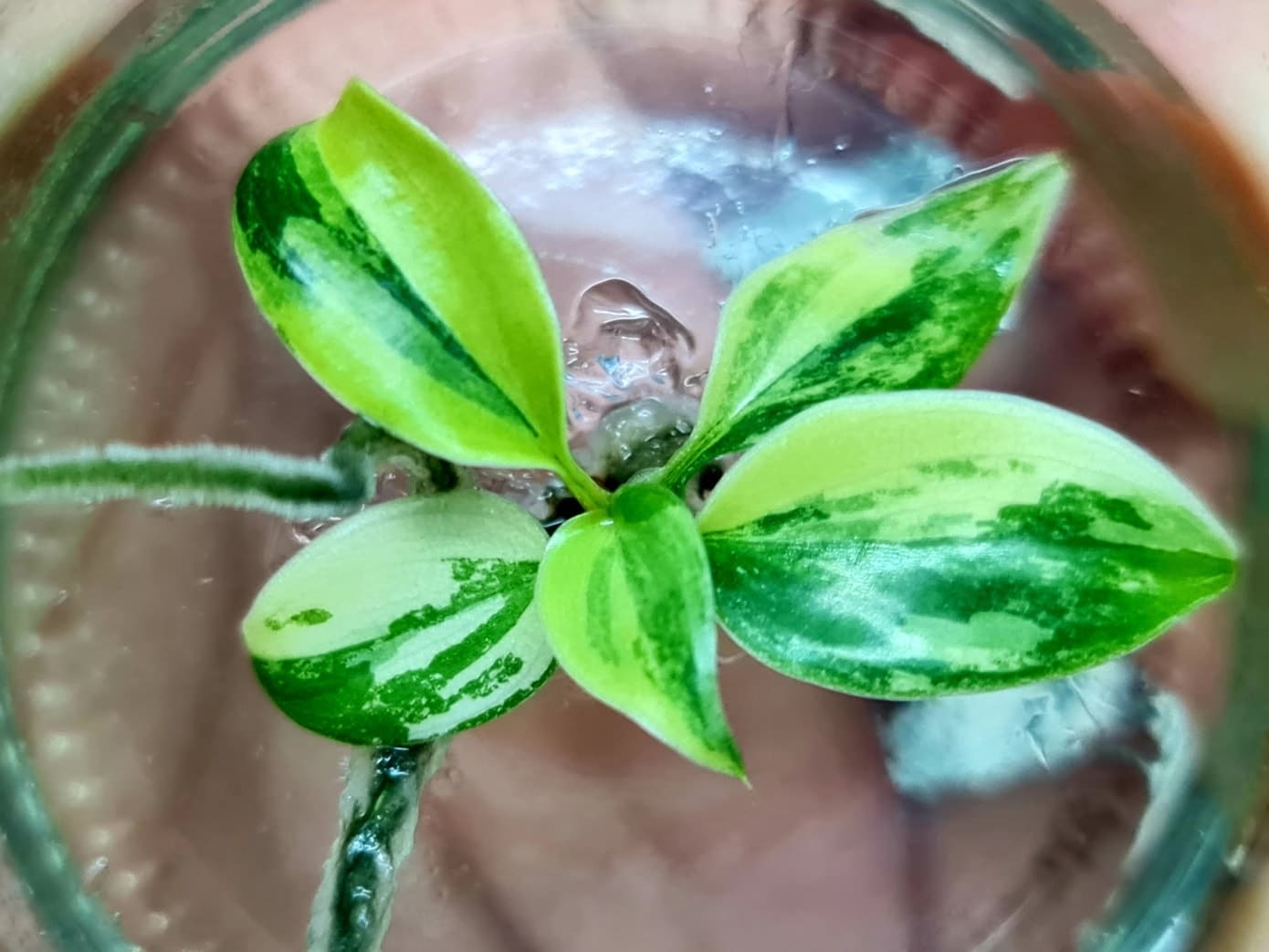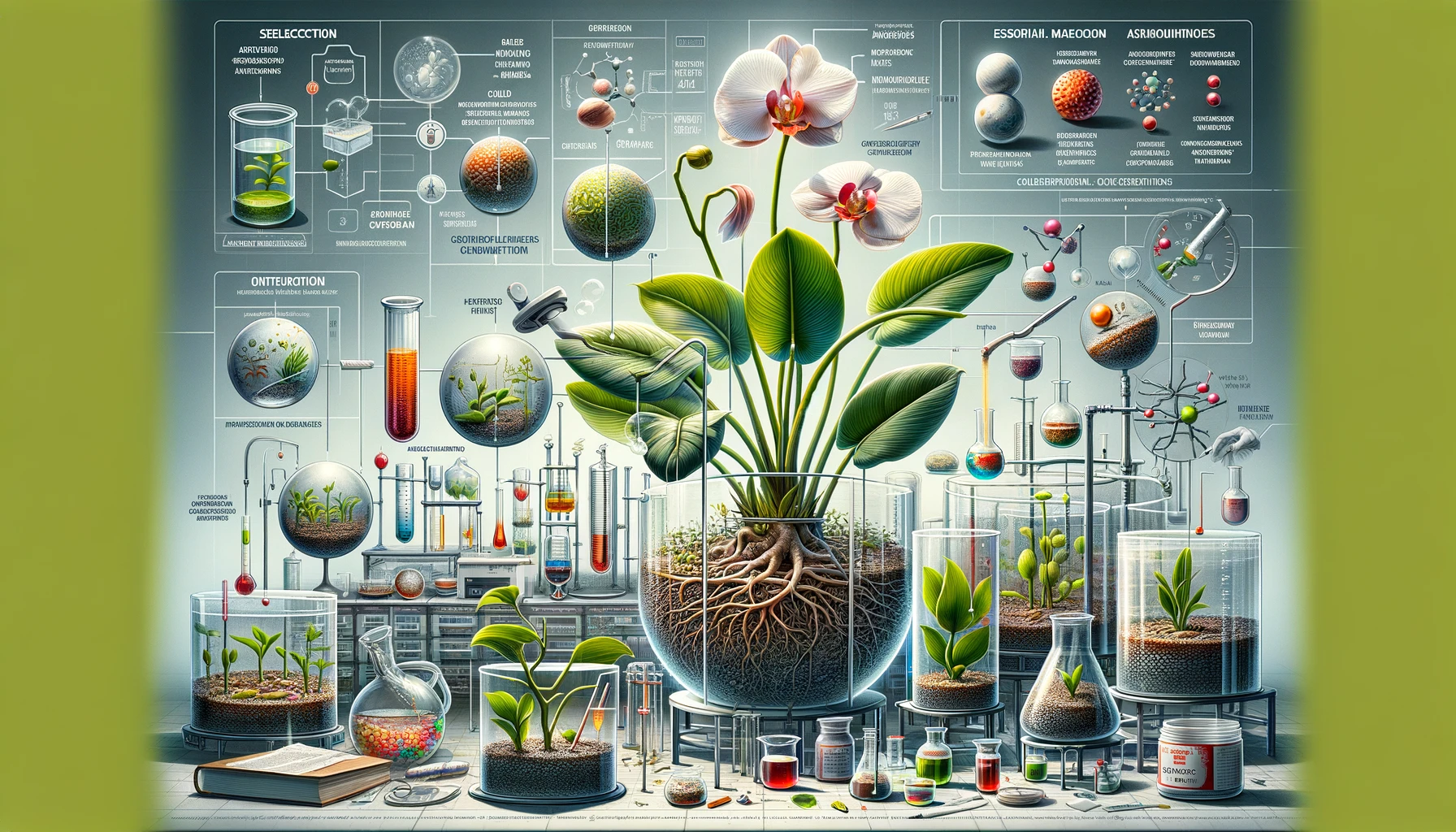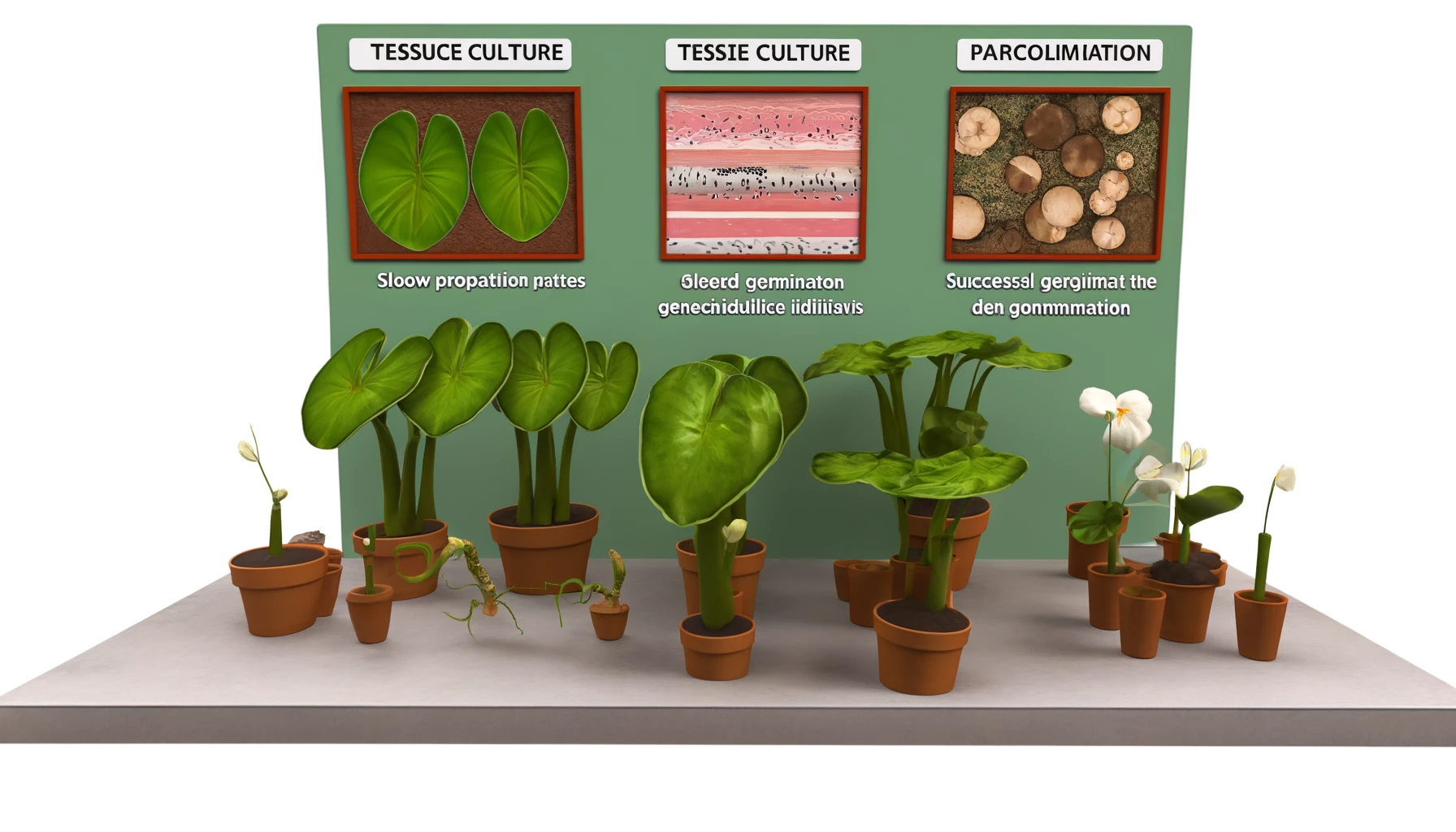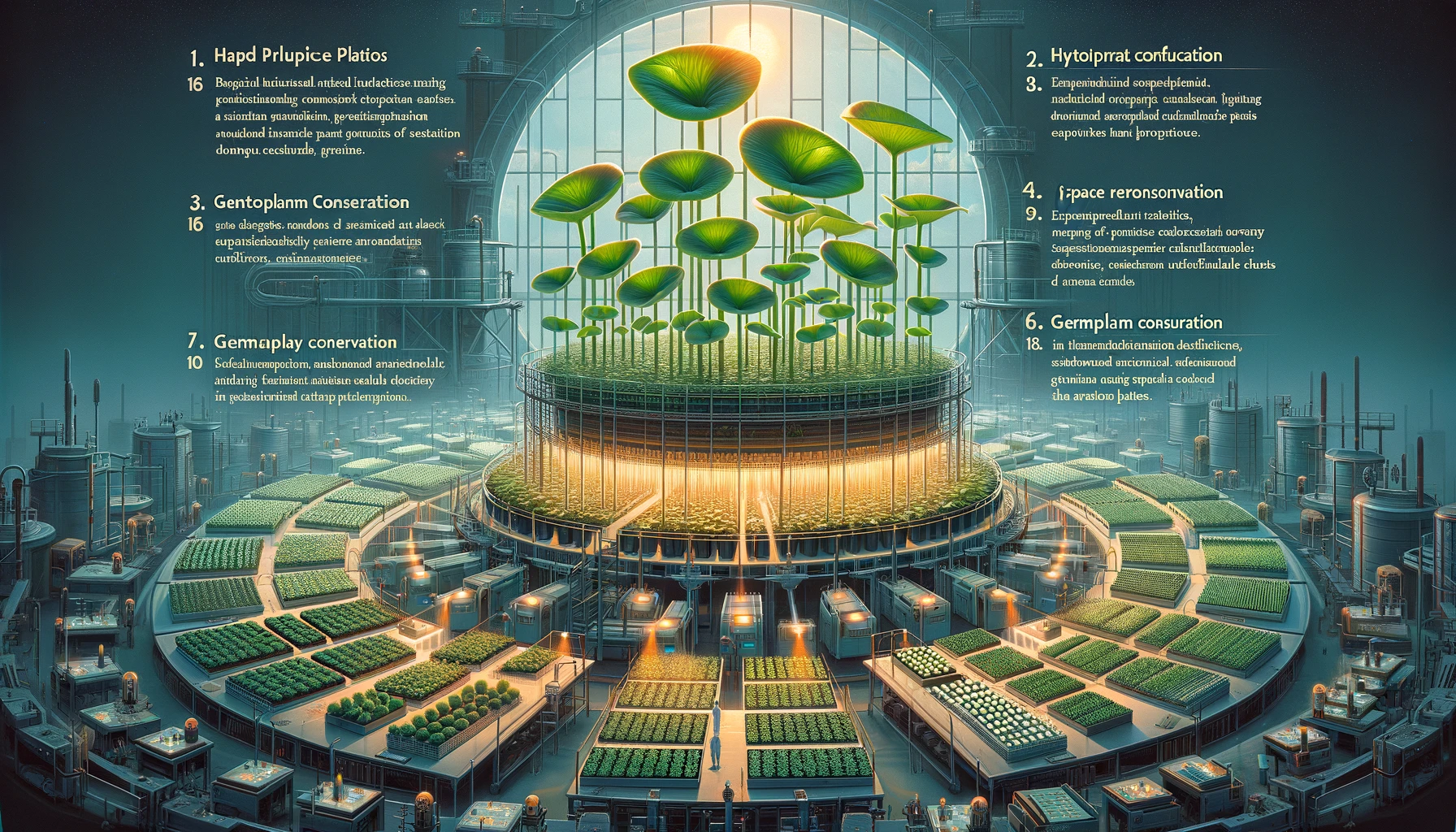The captivating world of aroid plants, encompassing diverse species like Anthurium, Philodendron, Monstera, and Alocasia, enthralls plant enthusiasts with their striking foliage, captivating blooms, and unique growth habits. However, traditional propagation methods for these plants can be challenging, often relying on cuttings, division, or seed germination, which can prove slow and unpredictable. Tissue culture, a revolutionary technique in plant propagation, presents a viable and highly efficient means of cultivating aroid plants, offering numerous advantages over traditional methods.

What is Tissue Culture?
Tissue culture, also known as micropropagation, involves the cultivation of plant cells, tissues, or organs in a controlled environment outside the plant’s natural habitat. This technique harnesses the remarkable ability of plant cells to dedifferentiate and regenerate into complete plants. The process typically begins with the isolation of a small piece of plant tissue, such as a leaf, shoot tip, or root. This tissue is carefully sterilized to eliminate any contamination and then placed in a sterile growth medium, often a nutrient-rich agar-gel, supplemented with hormones and other growth regulators. These specialized media provide the optimal conditions for cell division and growth. The cells divide and multiply rapidly, forming a mass of undifferentiated cells called a callus.

The Process of Tissue Culture
- Explant Selection and Preparation: The first step in tissue culture involves selecting and preparing the plant material, known as the explant. Explants can be derived from various plant parts, such as leaves, stems, roots, or meristematic tissues (shoot tips or axillary buds).
- Sterilization: To prevent contamination, the explant is thoroughly sterilized using disinfectants such as sodium hypochlorite, mercuric chloride, or ethanol. This step is crucial to ensure a sterile and controlled environment for the tissue culture process.
- Culture Initiation: The sterilized explant is then placed in a culture medium, typically composed of macro and micronutrients, vitamins, plant growth regulators, and a gelling agent (such as agar or gelatin). The culture medium provides the necessary nutrients and hormonal balance for the explant to initiate growth and development.
- Multiplication: Once the initial culture is established, the explant begins to proliferate, forming multiple shoots or callus (undifferentiated cell mass). This stage involves subculturing the explant onto fresh medium to encourage continued growth and multiplication.
- Rooting and Acclimatization: The regenerated shoots or plantlets are then transferred to a rooting medium, which promotes the formation of roots. After successful rooting, the plantlets are gradually acclimatized to the ex vitro (outside the culture vessel) conditions, allowing them to adapt to the natural environment.
Factors Influencing Tissue Culture Success
Several factors play a crucial role in the success of tissue culture, including:
- Plant Genotype: Different plant species and even cultivars within a species may exhibit varying responses to tissue culture conditions, necessitating optimization of protocols for specific aroid plants.
- Explant Source and Condition: The selection of healthy, actively growing explant material is essential for successful tissue culture. Factors such as the age, physiological state, and position of the explant on the parent plant can significantly impact the outcome.
- Culture Medium Composition: The nutrient medium, including the balance of essential macronutrients, micronutrients, vitamins, and plant growth regulators, must be tailored to the specific requirements of the aroid plant being cultured.
- Environmental Conditions: Parameters such as temperature, light intensity, photoperiod, and humidity within the culture vessel must be carefully controlled to optimize growth and development.
- Aseptic Technique: Maintaining a sterile environment throughout the tissue culture process is crucial to prevent microbial contamination, which can compromise the health and growth of the cultured plants.

Why Use Tissue Culture for Aroid Plants?
Aroid plants, known for their diverse and captivating foliage, pose unique challenges when it comes to traditional propagation methods. Tissue culture offers a solution to these challenges, providing a highly efficient and reliable means of cultivating these plants.
Overcoming Propagation Challenges
- Slow Growth and Low Propagation Rates: Many aroid plants, such as Philodendrons and Monsteras, exhibit slow growth and low propagation rates when propagated through traditional methods like cuttings or division. Tissue culture can significantly increase the rate of multiplication, allowing for the rapid production of genetically identical plants.
- Seed Dormancy and Recalcitrance: Some aroid species, like Caladiums, exhibit seed dormancy or recalcitrance, where seeds are difficult to germinate or fail to produce true-to-type offspring. Tissue culture bypasses these challenges, enabling the propagation of plants from small explant materials.
- Pathogen Contamination: Aroid plants can be susceptible to various pathogens, including fungi, bacteria, and viruses, which can be transmitted through traditional propagation methods. Tissue culture provides a sterile environment, minimizing the risk of disease transmission and ensuring the production of healthy, pathogen-free plants.

Preserving Genetic Diversity
Tissue culture techniques can also play a vital role in the conservation and propagation of rare or endangered aroid species. By establishing in vitro collections, researchers can maintain and multiply these valuable genetic resources, ensuring their long-term preservation and availability for future research and cultivation.
Facilitating Hybrid Development
Tissue culture can aid in the development of new aroid cultivars through hybridization. By using tissue culture techniques, researchers can efficiently propagate and evaluate hybrid plants, accelerating the breeding and selection process.
Benefits of Tissue Culture in Plant Propagation
Tissue culture offers a multitude of advantages over traditional propagation methods, making it a valuable tool for aroid plant cultivation.

Rapid Multiplication
One of the primary benefits of tissue culture is the ability to rapidly multiply plants. The high proliferation rates achieved through in vitro propagation allow for the production of large numbers of genetically identical plantlets in a relatively short time frame, significantly increasing the efficiency of plant production.
Improved Plant Health and Consistency
Tissue culture techniques provide a controlled and sterile environment, which helps to ensure the health and genetic uniformity of the propagated plants. By eliminating the risk of pathogen contamination and maintaining optimal growth conditions, tissue culture-derived plants often exhibit superior vigor, disease resistance, and consistent growth characteristics.
Year-Round Production
Tissue culture enables the propagation of plants independent of seasonal constraints. Unlike traditional propagation methods that may be limited by environmental factors, tissue culture allows for the continuous production of plants throughout the year, providing a consistent supply of high-quality material.
Space and Resource Efficiency
Tissue culture techniques require minimal physical space compared to traditional propagation methods. The compact in vitro systems and the ability to maintain large numbers of plantlets in a small footprint make tissue culture a highly efficient and space-saving approach to plant production.
Germplasm Conservation
Tissue culture plays a crucial role in the conservation of genetic resources, particularly for rare, endangered, or difficult-to-propagate aroid species. In vitro collections can serve as a living gene bank, preserving the genetic diversity of these valuable plant resources for future research and cultivation.
Improved Phytosanitary Status
The sterile environment and rigorous disinfection procedures employed in tissue culture help to eliminate the presence of pathogens, pests, and other contaminants. This results in the production of high-quality, disease-free plant material that can be safely transported and distributed, reducing the risk of pest and disease spread.
Facilitating Breeding and Selection
Tissue culture techniques can aid in the development of new aroid cultivars by enabling efficient hybridization, screening, and selection processes. The ability to rapidly propagate and evaluate hybrid plants can accelerate the breeding and cultivar development programs.
Potential for Transformation and Genetic Modification
Tissue culture systems provide a platform for genetic engineering and transformation, allowing for the introduction of desirable traits, such as improved stress tolerance or unique characteristics, into aroid plants. This can expand the range of available cultivars and create new opportunities for plant improvement.
Conclusion
Tissue culture has emerged as a transformative technique in the propagation and cultivation of aroid plants, offering a reliable and efficient alternative to traditional methods. By harnessing the regenerative power of plant cells, tissue culture enables the rapid multiplication of genetically uniform and disease-free plantlets, overcoming the challenges associated with slow growth and pathogen susceptibility. The numerous benefits of tissue culture, including improved plant health, year-round production, and enhanced germplasm conservation, have made it an invaluable tool for aroid plant enthusiasts, researchers, and commercial growers alike. As the field of tissue culture continues to evolve, the cultivation and preservation of these captivating aroid species will undoubtedly be transformed, opening new avenues for innovation and exploration in the world of plant propagation.
FAQs
What is Tissue Culture?
Tissue culture, also known as micropropagation, is a plant propagation technique that involves growing plant cells, tissues, or organs in a sterile, controlled environment on a nutrient-rich medium. This method can produce large numbers of new plants from a small amount of starting material.
Why Tissue Culture Aroids?
Aroids, a diverse family of plants that includes philodendrons, monsteras, and anthuriums, are popular among plant enthusiasts. Tissue culture offers several benefits for aroid propagation:
- Rapid multiplication: Many new plants can be produced quickly from a single explant (small piece of plant tissue).
- Disease-free plants: Tissue culture helps eliminate pathogens and viruses, resulting in healthier plants.
- Preservation of rare or endangered species: This technique can help conserve and propagate aroids that are difficult to propagate through traditional methods.
- Year-round propagation: Aroids can be propagated regardless of the season.
- Uniformity: Tissue culture produces clones, ensuring consistent traits in the new plants.
How Does Aroid Tissue Culture Work?
The process involves several steps:
- Explant selection and preparation: A small piece of plant tissue (e.g., leaf section, stem segment, shoot tip) is selected and sterilized to remove contaminants.
- Culture initiation: The sterilized explant is placed on a culture medium containing nutrients, plant growth regulators (hormones), and sometimes other supplements like activated charcoal or coconut water.
- Multiplication: The explant is subcultured multiple times to induce the formation of many shoots.
- Rooting: The shoots are transferred to a different medium with a higher concentration of auxin to encourage root development.
- Acclimatization: The plantlets are gradually weaned off the sterile environment and transitioned to soil or other growing media.
Types of Aroid Tissue Culture
- Meristem culture: Uses the shoot tip meristem to produce virus-free plants.
- Callus culture: Induces callus formation from explant tissue, which can then differentiate into shoots and roots.
- Organogenesis: Directly forming shoots or roots from the explant.
- Somatic embryogenesis: Developing embryos from somatic cells, resulting in complete plantlets.
Challenges and Considerations
While tissue culture is a powerful tool, it has some challenges:
- Contamination: Maintaining sterility throughout the process is crucial.
- Somaclonal variation: Some aroids may exhibit genetic changes in tissue culture, leading to variations in the offspring.
- Acclimatization: Plantlets may need careful adjustment to survive outside the controlled laboratory environment.
Is Tissue Culture for You?
If you’re passionate about aroids, enjoy experimentation, and have access to basic equipment and supplies, tissue culture can be a rewarding way to expand your collection and contribute to the preservation of rare or endangered species.
Ready to Dive into the World of Tissue Culture Aroids? Explore our curated collection of Tissue Culture Aroid Plants at Greenboog, where we’ve harnessed the power of science to bring you the most sought-after and rare varieties. From the vibrant variegation of Philodendrons to the striking foliage of Monsteras, our tissue-cultured plants are disease-free, robust, and ready to thrive in your collection. Discover the future of plant propagation and elevate your indoor jungle with Greenboog’s Tissue Culture Aroids.


